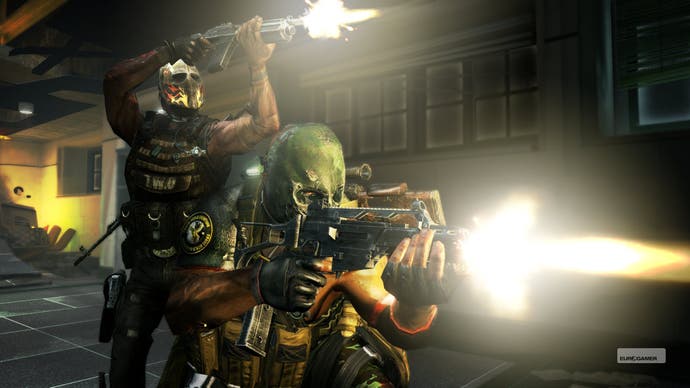Army of Two: The 40th Day
Flanks a lot.
From the duck-and-cover flanking gameplay, to making co-op a pivotal part of the design, to the bullish machismo of the main characters, the original Army of Two was a clear attempt to create an all-formats rival to Gears of War. That it only partially succeeded is probably down to the problems of trying to create something distinctive within the confines of a rigid genre formula, but there was certainly a promising shooter lukring beneath the slightly wonky control map, occasionally flaky AI and endless whooping fist-bumps.
It's to EA Montreal's credit then that despite a predictably quick turnaround time a great many of those grievances have been comprehensively addressed for the sequel. There's a welcome cosmetic overhaul, which makes the rather bland HUD elements more appealing and intuitive, and a general spit and polish to the graphics that results in more detailed and believable environments. The GPS overlay is more informative, weapon purchases and upgrades can be made at any time provided you're not in active combat, and there are lots of other small interface tweaks.
Anyone who played the original for any length of time will also appreciate the much simpler control scheme, which not only strips away the needlessly cluttered button layout of old, but allows you to do more with less effort. It's a bit silly that we had to wait for a sequel before a sprint function was added, but the ability to dash into the open, seamlessly vault over obstacles and roll or slide into cover with just one button compensates nicely. Aiming is also tighter and more fluid, transforming most confrontations into fast-paced action set-pieces rather than tiresome whack-a-mole wars of attrition.

The cover mechanic is another area that's been vastly improved. As Salem and Rios race around their new Shanghai setting, they can stand or crouch next to any surface offering protection from incoming fire and automatically stick to it, ready to blindfire over the top or around the corner. Moving away from the same surface instantly breaks you free, so if you're used to the strong glue of a Gears-style cover system this will take a little adjusting to, and you may sidle into harm's way a few times without realising. Over the course of the game, however, it's effective and intuitive, as you gain an instinctive understanding of when you're safe and when you need to keep moving. This ability to enter and leave cover on the fly also proves essential, especially when you reach the larger stand-offs where attacks come from all sides.
Yet more advances can be found playing solo, particularly in the much more flexible and dependable AI of your ever-present partner. Context-sensitive commands mean the other character can be used to perform pretty much any task you can do, from opening doors to grabbing enemies as hostages. The four-prong command system remains, with its double-tap for aggression simplicity, and as the character makes sensible use of cover, takes useful initiatives in combat and mostly acts as a genuine help, you'll find that it's easy to forget that your gun-toting pal is making his decisions based on algorithms driven by ones and zeroes.


